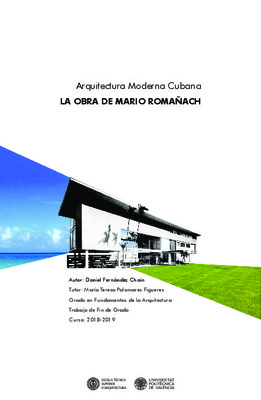JavaScript is disabled for your browser. Some features of this site may not work without it.
Buscar en RiuNet
Listar
Mi cuenta
Estadísticas
Ayuda RiuNet
Admin. UPV
Arquitectura moderna cubana. La obra de Mario Romañach
Mostrar el registro sencillo del ítem
Ficheros en el ítem
| dc.contributor.advisor | Palomares Figueres, María Teresa
|
es_ES |
| dc.contributor.author | Fernandez Chain, Daniel
|
es_ES |
| dc.coverage.spatial | east=-77.781167; north=21.521757; name=Cuba | es_ES |
| dc.date.accessioned | 2020-01-28T10:59:51Z | |
| dc.date.available | 2020-01-28T10:59:51Z | |
| dc.date.created | 2019-09-19 | |
| dc.date.issued | 2020-01-28 | es_ES |
| dc.identifier.uri | http://hdl.handle.net/10251/135831 | |
| dc.description.abstract | [ES] En Cuba, el Movimiento Moderno experimentó una llegada tardía. Fue en el contexto progresista y cosmopolita de La Habana de los años 30 que la arquitectura de vanguardia comenzó a expandirse, y no fue hasta los años 50 que esta alcanza su máximo esplendor. En sus inicios, las obras desarrolladas por el Movimiento Moderno cubano tenían una marcada influencia de los enunciados del racionalismo europeo y, en particular, de la estética maquinista de Le Corbusier. Pero a partir de 1948 surge una nueva forma de modernidad cubana, que buscaba una reconciliación entre vanguardia y tradición, vinculando los cánones del Movimiento Moderno con la situación geográfica, costumbres, clima, materiales y tradiciones locales. En ese escenario, Mario Romañach se convirtió en uno de los arquitectos más prolíficos de la modernidad cubana, con obras que destacan por su excelente calidad espacial y formal. Un arquitecto visionario que supo adaptar acertadamente las tesis funcionalistas del racionalismo al entorno tropical, creando un lenguaje moderno y regional al mismo tiempo. Razón por la cual, es considerado uno de los mejores arquitectos cubanos de todos los tiempos y, como el más imaginativo y transgresor de la primera mitad del siglo XX. | es_ES |
| dc.description.abstract | [EN] In Cuba, the Modernity had a late arrival. It was in the early 30s of last century within the advanced and cosmopolitan environment of Havana City that the vanguard architecture spread, and it was not until the 50s that it reached its maximum splendour. At first, the European influence fell on very fertile soil in Cuba, as the ideas of the Art Deco, Rationalism and International styles merged with the developing Cuban architectural trends. But in 1948 a new form of Cuban Modernity was born as innovative architects embraced not only the new materials and technologies, but also the traditional forms, materials and the local construction techniques of the past in their work. In this context, Mario Romañach became one of the most prolific architects of Cuban modernity with works that stand out for their excellent spatial and formal quality. A visionary architect who knew how to adapt the functionalist thesis of Western rationalism to the tropical environment, creating a modern and regionalist language at the same time. Getting to be considered one of the best Cuban architects of all times and, as the most imaginative and transgressive one of the first half of the twentieth century. | es_ES |
| dc.language | Español | es_ES |
| dc.publisher | Universitat Politècnica de València | es_ES |
| dc.rights | Reserva de todos los derechos | es_ES |
| dc.subject | Movimiento Moderno | es_ES |
| dc.subject | América Latina | es_ES |
| dc.subject | Cuba | es_ES |
| dc.subject | La Habana | es_ES |
| dc.subject | Romañach | es_ES |
| dc.subject | Modern Architecture | es_ES |
| dc.subject | Latin America | es_ES |
| dc.subject | Havana | es_ES |
| dc.subject.classification | COMPOSICION ARQUITECTONICA | es_ES |
| dc.subject.other | Grado en Fundamentos de la Arquitectura-Grau en Fonaments de l'Arquitectura | es_ES |
| dc.title | Arquitectura moderna cubana. La obra de Mario Romañach | es_ES |
| dc.type | Proyecto/Trabajo fin de carrera/grado | es_ES |
| dc.rights.accessRights | Abierto | es_ES |
| dc.description.bibliographicCitation | Fernandez Chain, D. (2019). Arquitectura moderna cubana. La obra de Mario Romañach. http://hdl.handle.net/10251/135831 | es_ES |
| dc.description.accrualMethod | TFGM | es_ES |
| dc.relation.pasarela | TFGM\113437 | es_ES |
Este ítem aparece en la(s) siguiente(s) colección(ones)
-
ETSA - Trabajos académicos [4687]
Escuela Técnica Superior de Arquitectura






